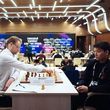23 July 2016
Delay and Punishment
Game six of the Gelfand-Inarkiev match in the review of Vladimir Barsky.
Game six is the last game of the match with the classical time control. While playing the white pieces, Boris Gelfand was not up to taking unnecessary risks once having barely survived the tribulations of the latest two match games. He refrained from both the English opening, which saw him on the brink of going down in game four, as well as from the Nimzo-Indian Defence, in which the strategically complex non-standard setups are open to fighting for three results. This said, the Queen's Indian Defense is suited perfectly well to serve an occasion like this! As White enjoys a small plus, he can go on pressurizing his opponent indefinitely without any particular risk for himself.
However, Ernesto Inarkiev would not put up with a similar standard scenario planned for this opening. After all, games four and five were unfolding under his dictation, this is why he was willing to get into a sharp type of position with opportunities to take over initiative at some moment later. He opted for a trendy line that has been recently successfully employed by Sergey Karjakin, whereas Boris Gelfand came back with a relatively rare but ambitious plan of rerouting the dark-squared bishop from d2 onto the big diagonal and mounting the knight on e5, shoring it up later with the f-pawn. After the game Gelfand explained that this idea had been harnessed by no less a person than Mikhail Botvinnik himself. Besides, there exist other games played in this line as well.
Ernesto's reaction was the most principled one: he traded his dark-squared bishop for the c3-knight to station his knight in the center as well. Had Black succeeded in driving the white knight away with f7-f6, his game would have become full-fledged with chances to fight for the initiative. However, Inarkiev made an indecisive move, which was enough for White to create dangerous threats on the kingside. Gelfand's energetic and ingenious offensive fetched him a nice victory. The score has become 8:4 in his favor.
Gelfand – Inarkiev
Queen's Indian Defense
1.d4 Nf6 2.c4 e6 3.Nf3 b6 4.g3 Ba6
Boris Gelfand: This is a trendy line nowadays. This opening could be described as having fetched victory to Sergey Karjakin in the Candidates Tournament.
5.b3 d5 6.Bg2 Bb4+ 7.Bd2 Be7 8.cd ed 9.0-0 0-0 10.Nc3 Re8 11.Ne5
11.Qc2 Bb7 12.Rfd1 Na6 13.Bf4 c6 14.a3 Nc7 15.b4 Bf8 16.Be5 a5 17.Ng5 Bd6 18.B:f6 Q:f6 19.Q:h7+ Kf8 20.Qh5 Qg6 21.Q:g6 fg 22.Rab1 ab 23.ab Be7 24.Nf3 Ra3 25.Rdc1 Bd6 26.e3 Bc8 27.Ne2 Bd7 28.Ne5 B:e5 29.de Nb5 30.e6 R:e6 31.Bh3 Ke7 32.B:e6 K:e6 33.Ra1 Rb3 34.Rcb1 R:b1+ 35.R:b1 Kd6 36.f3 Na3 37.Kf2 N:b1 0-1, as in Gelfand – Oparin, Moscow 2015.
11...Bb7 12.Bc1
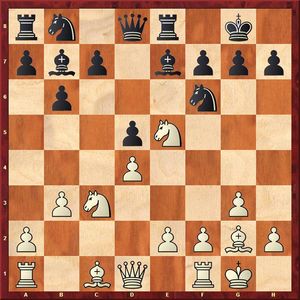
Boris Gelfand: This idea is employed rather infrequently. It was played in ancient times by Botvinnik against Bronstein, while one of the recent examples includes the game between Giri and Karjakin from the latest Candidates Tournament. Larsen was among those playing this line for Black.
12...Nbd7 13.Bb2 Bd6
13...Bf8 14.Rc1 (14.f4 c5 15.e3 cd 16.ed Ne4 17.N:e4 de 18.Qe2 Nf6 19.g4 Nd5 20.B:e4 f6 21.Qd3 g6 22.B:g6 Re7 23.Nf7 R:f7 24.B:f7+ K:f7 25.Q:h7+ Bg7 26.g5 Qd6 27.g6+ Kf8 28.Rae1 Nb4 29.Qh3 Qd5 30.Re3 Rc8 31.Rfe1 f5 32.R1e2 a5 33.Kf2 Ba6 34.Re5 B:e5 35.R:e5 Nd3+ 36.Kg3 N:e5 37.fe Bb7 38.Qh8+ Ke7 39.Qf6+ Kd7 40.Q:f5+ Kc7 41.Qf7+ Q:f7 42.gf Bd5 43.Kf4 Kd7 44.h4 Ke7 45.h5 K:f7 0-1, as in Evans – Larsen, San Antonio 1972) 14...N:e5 15.de R:e5 16.Nb5 Re7 17.B:f6 gf 18.e4 de 19.Qg4+ Bg7 20.Rfd1 Qf8 21.Nd4 Bc8 22.Qh4 f5 23.Nc6 Re8 24.Bh3 Bh6 25.Rc2 e3 26.fe B:e3+ 27.Kh1 Be6 28.Bg2 a5 29.Bf3 Kh8 30.Nd4 Rad8 31.R:c7 Bd5 32.Re1 Qd6 33.Rc2 Re4 34.B:e4 B:e4+ 35.Q:e4 fe 36.Nf5 Qb4 37.R:e3 Rd1+ 38.Kg2 Rd2+ 39.R:d2 Q:d2+ 40.Kh3 Qf2 41.Kg4 f6 0-1, as in Botvinnik – Bronstein, Moscow 1951.
14.f4
Boris Gelfand: If you go for this line, you need to adopt a principled approach. The game is of a complex nature, each move being committal for both sides.
Giri's move here was a rather strange 14.Nd3 a5 15.Rc1 c6 16.Na4 Rc8 17.e3 Ba6 18.Re1 h5 19.Bh3 Ng4 20.Nf4 g6 21.B:g4 hg 22.Q:g4 Nf6 23.Qg5 Be7 24.N:g6 fg 25.Q:g6+ Kh8 26.Nc5 bc 27.dc Rf8 28.Qh6+ Kg8 29.Qg6+ Kh8 30.Qh6+ Kg8 1/2-1/2, as in Giri – Karjakin, Moscow 2016.
14...c5 15.e3
Boris Gelfand: Let us skip the opening part of the game.
15...cd 16.ed Bb4
Boris Gelfand: This is a principled move.
17.Rc1 B:c3 18.R:c3
Boris Gelfand: I could have also recaptured with the bishop – 18.B:c3.
Vladimir Barsky: Is Black somehow bound to part with his dark-squared bishop?
Boris Gelfand: No, this is just one of the possible plans, but he could play more simple chess. However, this is a principled approach: if Black is in time to mount his knight on e4 and play f7-f6, he might end up being superior. If 18.B:c3 Ne4, then White throws in 19.Qh5 immediately.
18...Ne4 19.Rc2
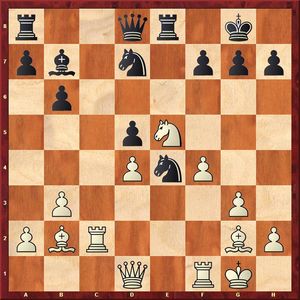
19...Nf8
Boris Gelfand: My natural response to 19...N:e5 would be 20.de, of course.
19...f6 seems like a principled move to me. Honestly speaking, I was not sure what to do in this case. Perhaps, I am bound to go for 20.Nc6 B:c6 21.R:c6 f5…
Ernesto Inarkiev: White's command of the c-file is a powerful lever.
Boris Gelfand: I could play 22.Qh5 g6 (22...Nb8? 23.Rd6!) 23.R:g6+; I have a perpetual, at the very least. On the other hand, it is hard to say if I should count for anything more than that. Even though Black surrendered possession of the c-file, after Ndf6 he is not without his own trump cards either.
Meanwhile, after 19...Nf8 20.Qh5 Black's position is not a good one already.
A question from the audience: Would you have forced a draw by perpetual after 19...f6?
Boris Gelfand: I am not sure, I would have calculated all possible lines first.
20.Qh5 g6
Boris Gelfand: This is forced as Black is unable to defend the f7-square by other means: 20...Ng6 21.f5 or 20...Qe7 21.Ba3.
21.Qh6 f6
Boris Gelfand: The best defense is, perhaps, 21...Nd6, but then 22.g4. My threat is f4-f5, and if 22...f6, then 23.Nc6 B:c6 24.R:c6 – the d5-pawn is hanging and it is unclear how Black is supposed to defend his position.
Editor's note: in lieu of 23…B:c6 Black has a nice defensive resource 23...Qd7! 24.B:d5+ Nf7. On the other hand, White is also able to improve his play: in lieu of 23.Nc6 better is 23.f5! g5 24.Rfc1 or 23...fe 24.f6 Qd7 25.de.
22.B:e4! fe
Boris Gelfand: If 22...de, then 23.Ng4, and Black is defenseless against either d4-d5 or f4-f5.
Ernesto Inarkiev: My initial idea was to play 23...Rc8 24.R:c8 B:c8…
Boris Gelfand: At the very least I could play 25.Ne3 with an overwhelming position, but I feel like having seen something tougher than that over the board...
Ernesto Inarkiev: 25.f5 is very strong.
Boris Gelfand: That's right!
Ernesto Inarkiev: In the beginning I was of the opinion that following 25...B:f5 26.R:f5 gf 27.N:f6+ Kf7 Black's position is acceptable, but there is a quiet move 28.d5!
Boris Gelfand: White is dominating.
23.f5
Boris Gelfand: The toughest continuation.
23...Re7
Boris Gelfand: The only move, if 23...de, then 24.f6.
24.Bg2 e4 25.Ba3 Rf7 26.fg
Boris Gelfand: Another interesting move is 26.Rcf2 with the idea 26...Rg7 27.B:f8 Q:f8 28.fg – leaving Black down a pawn without any compensation for it. However, the text move is no less tough, from my point of view.
26...R:f1+ 27.B:f1 N:g6 28.Rf2 Qd7
Boris Gelfand: This is a losing move, the only continuation to keep Black in the game would have been 28...Rc8. In this case after 29.Bh3 Rc6 30.Bf5 Black's position is very grim, he has no useful moves at all. As the threat is B:f6 followed by Rf8+, the only defense is 30...Rf6, but then 31.h4, and Black is in some sort of a zugzwang.
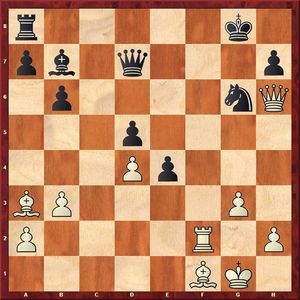
29.Bh3! Qc6
29...Qg7 30.Be6+ Kh8 31.Q:g7+ K:g7 32.Rf7+.
30.Be7 e3 31.Rf6 Qc1+
Boris Gelfand: There is one nice line here: 31...e2 32.Be6+ Kh8
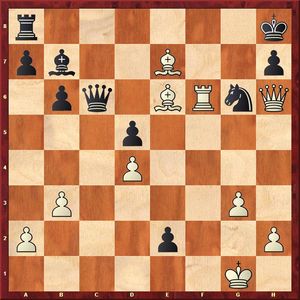
33.Rf8+ R:f8 34.Q:f8+ N:f8 35.Bf6#.
32.Rf1 Qc6 33.Bf6 Black resigns.
On Thursday, July 21, three rapid games with time control 15 minutes till the end of the game plus a 10-second increment per move will be played in Magas. Game 7 starts at 15.00 p.m. Moscow time, Inarkiev playing the white pieces.





















